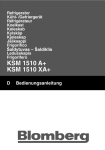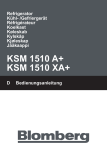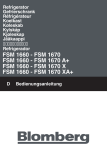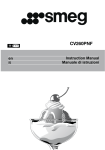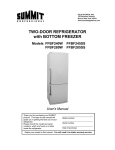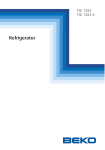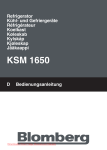Download DNM 1840-DNM 1860 T DNM 1840-DNM 1860 XT
Transcript
Refrigerator Kühl- und Gefriergeräte Réfrigérateur Koelkast DNM 1840-DNM 1860 T DNM 1840-DNM 1860 XT D Bedienungsanleitung GB Index 1-8 Safety first/1 Electrical requirements/2 Transportation instructions/2 Installation instructions/2 Getting to know your appliance/3 Suggested arrangement of food in the appliance/3 Temperature control and adjustment/4 Before operating/4 Storing frozen food/5 Freezing fresh food/5 How to use the accessories/5 Replacing the interior light bulb/6 Cleaning and care/6 Do’s and don’ts/7 Trouble - shooting/8 Repositioning the doors/8 D Inhalt 01-08 Wichtige Sicherheitshinweise/1 Elektrische Anforderungen/2 Transporthinweise/2 Aufstellen des Gerätes/2-3 Lernen Sie Ihr neues Gerät kennen/3 Empfohlene Lagerung der Lebensmittel in Ihrem Gerät/3 Temperaturkontrolle und -einstellung/4 Vor der Inbetriebnahme zu beachten/4 Lagerung von Tiefkühlkost/5 Frische Lebensmittel Tiefkühlen /5 Verwendung des Zubehörs/5-6 Austausch der Glühbirne der Innenbeleuchtung/6 Reinigung und Pflege/6 Wichtige Hinweise – Bitte beachten!/7 Fehlerbeseitigung/8 Änderung des Türanschlags/8 Garantiebedingungen/9 F Sommaire 10-17 Priorité à la sécurité/10 Exigences électriques/11 Instructions pour le transport/11 Instructions pour l’installation/11-12 A la découverte de l’appareil/12 Suggestion de rangement des aliments dans l’appareil/12 Contrôle et réglage de la température/13 Avant la mise en marche/13 Conservation des aliments surgelés/14 Congélation d’aliments frais/14 Procédure d’utilisation des accessoires/14-15 Remplacement de l’ampoule d’éclairage intérieur/15 Nettoyage et entretien/15 A faire et à ne pas faire/16 Dépannage/17 NL Inhoud 18-25 Veiligheid voor alles/18 Elektrische vereisten/19 Vervoerinstructies/19 Instructies voor de installatie/19-20 Het apparaat leren kennen/20 Aanbevolen rangschikking van levensmiddelen in het apparaat/20 Temperatuur regelen en instellen/21 Voordat u het apparaat in gebruik neemt/21 Bewaren van bevroren levensmiddelen/22 Invriezen van verse levensmiddelen/22 Accessoires gebruiken/22-23 Het lampje van de binnenverlichting vervangen/23 Schoonmaken en onderhoud/23 Wat wel en wat niet mag /24 Problemen oplossen/25 De deur omdraaien/25 1 15 2 3 15 16 4 17 5 6 7 5 17 8 5 9 10 18 11 12 19 17 13 14 17 DNM 1840 1 15 2 3 15 1 4 17 5 6 7 5 8 16 DNM 1860 17 2 3 4 5 6 7 8 9 10 11 12 13 14 15 16 11 4 5 4 2 1 12 6 8 13 14 3 45 ° 10 7 9 15 22 21 20 180° 22 25 27 26 24 27 23 17 19 16 19 18 17 48 1676 00 01 Instructions for use Congratulations on your choice of a Quality Appliance, designed to give you many years of service. Safety first! Do not connect your appliance to the electricity supply until all packing and transit protectors have been removed. • Leave to stand for at least 4 hours before switching on, to allow compressor oil to settle, if transported horizontally. • If you are discarding an old appliance with a lock or latch fitted to the door, ensure that it is left in a safe condition to prevent the entrapment of children. • This appliance must only be used for its intended purpose i.e the storing and freezing of edible foodstuff. • Do not dispose of the appliance on a fire. Your appliance contains non CFC substances in the insulation which are flammable. We suggest you contact your local authority for information on disposal and available facilities. • We do not recommend use of this appliance in an unheated, cold room. (e.g. garage, conservatory, annex, shed, out-house etc.) To obtain the best possible performance and trouble free operation from your appliance it is very important to read these instructions carefully. Failure to observe these instructions may invalidate your right to free service during the guarantee period. Please keep these instructions in a safe place for easy reference. 1 Instructions for use Electrical requirements Installation instructions Before inserting the plug into the wall socket make sure that the voltage and the frequency shown in the rating plate inside the appliance corresponds to your electricity supply. Ensure that the plug remains readily accessible. Do not use multiple adapter bar or extension cable. 1. Do not keep your appliance in a room where the temperature is likely to fall below 10 ° C at night and/or especially in winter, as it is designed to operate in ambient temperatures between +10 and +43 ° C. At lower temperatures the appliance may not operate, resulting in a reduction in the storage life of the food. 2. Do not place the appliance near cookers or radiators or in direct sunlight, as this will cause extra strain on the appliance's functions. If installed next to a source of heat or freezer, maintain the following minimum side clearances: From Cookers 30 mm From Radiators 300 mm From Freezers 25 mm 3. Make sure that sufficient room is provided around the appliance to ensure free air circulation. • The lower air-circulation cover inside your refrigerator should be placed below the door, by facing the counter parts as seen in(Fig. 2). Be sure that the counter parts meshed completely. •For efficient functioning, there should be a gap of at least 5 cm between the refrigerator and the wall. To ensure this, attach the two round buffers to be found inside the No Frost appliance, as shown in the illustration(Fig. 3). 4. The appliance should be positioned on a smooth surface. The two front feet can be adjusted as required. To ensure that your appliance is standing upright adjust the two front feet by turning clockwise or anti-clockwise, until firm contact is secured with the floor. Correct adjustment of feet prevents excessive vibration and noise. 5. Refer to "Cleaning and Care" section to prepare your appliance for use. Warning! This appliance must be earthed. Repairs to electrical equipment should only be performed by a qualified technician. Incorrect repairs carried out by an unqualified person risks that may have critical consequences for the user of the appliance. Transportation instructions 1. The appliance should be transported only in upright position. The packing as supplied must be intact during transportation. 2. If during the course of transport the appliance, has been positioned horizontally, it must not be operated for at least 4 hours, to allow the system to settle. 3. Failure to comply with the above instructions could result in damage to the appliance, for which the manufacturer will not be liable for. 4. The appliance must be protected against rain, moisture and other atmospheric influences. Important! • Do not attempt to sit or stand on top of your appliance as it is not designed for such use. You could injure yourself or damage the appliance. • Make sure that the mains cable is not caught under the appliance during and after moving, as this could damage the cable. • Do not allow children to play with the appliance or tamper with the controls. 2 Instructions for use Suggested arrangement of food in the appliance Getting to know your appliance (Fig. 1) Guidelines for obtaining optimum storage and hygiene: 1. The fridge compartment is for the short-term storage of fresh food and drinks. 2. The freezer compartment is rated and suitable for the freezing and storage of prefrozen food. The recommendation for storage as stated on the food packaging should be observed at all times. 3.•Hot meals should be cooled down to room temperature before putting into the refrigerator. •Food that you want to freeze should be in good quality and fresh. •Food should be separated into portions according to the daily or meal needs. •Even if food will be stored for a short period, food should be wrapped so that will not leak air to prevent drying. Packing materials should be resistant to cold, being torn, moisture, odor, oil and acid. And also should not let air-pass through. Besides they should be closed well, handy and made of convenient material for using in the deep freezers. 4. Dairy products should be stored in the special compartment provided in the door liner. 5. Cooked dishes should be stored in airtight containers. 6. Fresh wrapped products can be kept on the shelf. Fresh fruit and vegetables should be cleaned and stored in the crisper bins. 7. Bottles can be kept in the door section. 8. To store raw meat, wrap in polythene bags and place on the lowest shelf. Do not allow to come into contact with cooked food, to avoid contamination. For safety, only store raw meat for two to three days. 9. For maximum efficiency, the removable shelves should not be covered with paper or other materials to allow free circulation of cool air. 10. Do not keep vegetable oil on door shelves. Keep the food packed, wrapped or covered. Allow hot food and beverages to cool before refrigerating. Leftover canned food should not 1. Thermostat knob 2. Freezer compartment shelf 3. Ice cube tray (DNM 1840) / Ice-matic (DNM 1860) 4. Refrigerator compartment knob 5. Refrigerating-compartment shelves 6. Wine rack 7. Interior light 8. Chiller zone/crisper compartment setting sliders 9. Chiller zone/crisper compartments 10. Crisper humidity-control knob 11. Crisper cover 12. Crispers 13. Lower air-circulation cover 14. Adjustable front feet 15. Door-shelf of freezer-compartment 16. Egg holder 17. Door-shelves of refrigerating compartment 18. Wire frame 19. Bottle holder 3 Instructions for use be stored in the can. 11. Fizzy drinks should not be frozen and products such as flavoured water ices should not be consumed too cold. 12. Some fruit and vegetables suffer damage if kept at temperatures near 0°C. Therefore wrap pineapples, melons, cucumbers, tomatoes and similar produce in polythene bags. 13. High-proof alcohol must be stored upright in tightly closed containers. Never store products that contain an inflammable propellant gas (e.g. cream dispensers, spray cans, etc.) or explosive substances. These are an explosion hazard. positions (Fig. 5). Important ! •The temperature of freezer compartment is affected by environmental conditions and upper compartments. •When the temperatures of the freezer and refrigeration compartments are adjusted to maximum, food stored just below the adjuster of the refrigeration compartment may freeze. Before operating Final Check Before you start using the appliance check that: 1. The feet have been adjusted for perfect levelling. 2. The interior is dry and air can circulate freely at the rear. 3. The interior is clean as recommended under "Cleaning and care.” 4. The plug has been inserted into the wall socket and the electricity is switched on. When the door is open the interior light will come on. Temperature control and adjustment •Internal temperature changes of the refrigerator which consists freezer compartment and refrigeration compartment can be adjusted by the thermostat adjustment knob on the illuminated panel. Operating temperatures are controlled by the thermostat knob (Fig. 4) and may be set at any position between MIN. and MAX. (the coldest position). The average temperature inside the fridge should be around +5°C. Therefore adjust the thermostat to obtain the desired temperature. Some sections of the fridge may be cooler or warmer (such as salad crisper and top part of the cabinet) which is quite normal. We recommend that you check the temperature periodically with a thermometer to ensure that the cabinet is kept to this temperature. Frequent door openings cause internal temperatures to rise, so it is advisable to close the door as soon as possible after use. •Refrigeration compartment temperature adjustment: The temperature of the refrigeration compartment depends on the amount of air from the freezer. You can make the temperature adjustment of the refrigeration compartment placed on the back wall of the refrigeration compartment by bringing the adjuster between 1 and MAX. And note that: 5. You will hear a noise as the compressor starts up. The liquid and gases sealed within the refrigeration system may also make some (noise), whether the compressor is running or not. This is quite normal. 6. Slight undulation of the top of the cabinet is quite normal due to the manufacturing process used; it is not a defect. 7. We recommend setting the thermostat knob midway and monitor the temperature to ensure the appliance maintains desired storage temperatures (See section Temperature Control and Adjustment). 8. Do not load the appliance immediately it is switched on. Wait until the correct storage temperature has been reached. We recommend checking the temperature with an accurate thermometer (see; Temperature Control and Adjustment). 4 Instructions for use Storing frozen food humidity-control knob to the position appropriate to the degree of moisture and coldness of the foodstuffs inside. If you want these to cool further, set the control to “Open”, if you want them to cool less but retain their moisture for a long period, set it to “Closed”. Positions in between allow you to regulate cooling and moisture-retention as you desire. Your freezer is suitable for the long-term storage of commercially frozen foods and also can be used to freeze and store fresh food. If there is a power failure, do not open the door. Frozen food should not be affected if the failure lasts for less than 8 hrs. If the failure is longer, then the food should be checked and either eaten immediately or cooked and then re-frozen Odor filter The odor filter on top of your fresh food compartment prevents formation of bad smell in your product . To clean the odor filter, remove the plastic cover and leave the filter under sun light for a day. Filter will be cleaned during this time period. Fit the filter back to its place (Fig. 14). Perform this operation once a year. Freezing fresh food Please observe the following instructions to obtain the best results. Do not freeze too large a quantity at any one time. The quality of the food is best preserved when it is frozen right through to the core as quickly as possible. Do not exceed the freezing capacity of your appliance in 24 h. Placing warm food into the freezer compartment causes the refrigeration machine to operate continuously until the food is frozen solid. This can temporarily lead to excessive cooling of the refrigeration compartment. When freezing fresh food, keep the thermostat knob at medium position. Small quantities of food up to 1/2 kg. (1 lb) can be frozen without adjusting the temperature control knob. Take special care not to mix already frozen food and fresh food. Tilt -out bin Tilt-out is used as shown in Fig. 6-7-8 Chiller zone/Second layer crisper compartments You can use these compartments in two alternatives by setting the plastic slider (Fig. 12). • Usage as chiller zone compartment alternative If you push down the plastic sliders at the right left bottom corners as shown in the Fig.12, the cold air flows in to compartment. So this compartment will become chiller zone compartment. This compartment can be used in order to put frozen food that you want to melt and to put food before freezing • Usage as second layer crisper compartment alternative If you push the plastic sliders up, the compartment can be used as a crisper. Note That: -Any of the two compartments can be used as second layer crisper while the other is adjusted to chiller zone compartment. - If you have adjusted the compartment at right or left chiller zone compartment, you can not How to use the accessories Crisper humidity controls This has been designed to keep your vegetables fresh, without losing moisture (Fig. 13). For this purpose, cold air circulates around the crisper. The amount of cold air passing out of the crisper can be regulated with the controls found on the front of its cover. You may set the 5 Instructions for use Replacing the interior light bulb - If you have adjusted the compartment at right or left chiller zone compartment, you can not slide it to right or left. If you slide it, since it becomes far away from the air channel, required coldness can not be achieved in this compartment. WARNING! Lood food chiller zone/second layer crisper according to your selection (crisper or chiller zone). Otherwise your food may face extra cooling or insufficient cooling. Should the light fail, switch off at the socket outlet and pull out the mains plug. Then ensure the bulb is screwed securely in the bulb holder. Replace the plug and switch on. If the light still fails, obtain a replacement E14 screw-cap type 15 Watt (Max) bulb from your local electrical store and then fit it. Carefully dispose of the burnt-out light bulb immediately. You can also move chiller zone/second layer crisper compartments as shown in Fig.10-11 Cleaning and care Beverage bin This feature is designed for horizontal storage of bottles. You can slide beverage bin in the horizontal direction to adjust the useful space below it. When you want remove the beverage bin, remove the glass shelf from the cabinet. Then by sliding the beverage bin to left you can remove it. To fit it back perform the above action in reverse order (Fig.9). Ice-matic Fill the ice-matics with water and put them in place. Your ice will be ready in about two hours. You needn’t take the ice-matic out in order to get ice; just turn it 90° to the right, and the ice will drop into the ice-bowl below. Then take out the ice-bowl to serve the ice. If you wish, you can leave the ice in the bowl for a while (Fig. 15-16). Attention! The ice-bowl is only meant for collecting ice. If you put water in, it will break. 6 1. We recommend that you switch off the appliance at the socket outlet and pull out the mains plug before cleaning. 2. Never use any sharp instruments or abrasive substances, soap, household cleaner, detergent or wax polish for cleaning. 3. Use luke warm water to clean the cabinet of the appliance and wipe it dry. 4. Use a damp cloth wrung out in a solution of one teaspoon of bicarbonate of soda to one pint of water to clean the interior and wipe it dry. 5. Make sure that no water enters the temperature control box. 6. If the appliance is not going to be used for a long period of time, switch it off, remove all food, clean it and leave the door ajar. 7. We recommend that you polish the metal parts of the product (i.e. door exterior, cabinet sides) with a silicone wax (car polish) to protect the high quality paint finish. 8. Check door seals regularly to ensure they are clean and free from food particles. 9. Never: • Clean the appliance with unsuitable material; e.g. petroleum based products. • Subject it to high temperatures in any way, • Scour, rub etc., with abrasive material. 10. Removing the door shelves : • To remove a door shelf, remove all the contents and then simply push the door shelf upwards from the base. Instructions for use Do’s and don’ts Do- Wrap all food in aluminium foil or freezer quality polythene bags and make sure any air is excluded. Do- Prepare fresh food for freezing in small portions to ensure rapid freezing. Do- Always choose high quality fresh food and be sure it is thoroughly clean before you freeze it. Do- Store commercially frozen food in accordance with the instructions given on the packets. Do- Keep food for as short a time as possible and adhere to "Best Before" and "Use by" etc. dates. Do- Check contents of the freezer every so often. Do- Wrap cheese firstly in greaseproof paper and then in a polythene bag, excluding as much air as possible. For best results, take out of the fridge compartment an hour before eating. Do- Wrap bread well to keep it fresh. Do- Chill white wines, beer, lager and mineral water before serving. Do- Wrap frozen food immediately after purchasing and put it in to the freezer as soon as possible. 7 Don't- Store bananas in your fridge compartment. Don't- Cover the shelves with any protective materials which may obstruct air circulation. Don't- Store poisonous or any dangerous substances in your appliance. It has been designed for the storage of edible foodstuffs only. Don't- Consume food which has been refrigerated for an excessive length of time. Don't- Store cooked and fresh food together in the same container. They should be packaged and stored separately. Don't- Leave the door open for long periods, as this will make the appliance more costly to run. Don't- Put hot food into the appliance. Let it cool down first. Don't- Put liquid-filled bottles or sealed cans containing carbonated liquids into the freezer, as they may burst. Don't- Exceed the maximum freezing loads when freezing fresh food. Don't- Give children ice-cream and water ices direct from the freezer. The low temperature may cause 'freezer burns' on lips. Don't- Freeze fizzy drinks. Don't- Try to keep frozen food which has thawed; it should be eaten within 24 hours or cooked and refrozen. Don't- Remove items from the freezer with wet hands. Instructions for use Trouble - shooting •Carefully lay the appliance on its back. (8) (You may need somebody to help you.) •Unscrew and remove the left hand side front feet. (9) •Unscrew and remove the bottom hinge. (10) •Reposition the plastic covers on top of fresh food door to the opposite side. (11) •Unscrew and remove the middle hinge bushing from freezer door. (12) •Screw and fix the new middle hinge bushing which is supplied in IB bag to the other side.(13) •Reposition the hinge bushing and the tap on the fresh food door. (14) •Unscrew and reposition the bottom hinge bushing. (15) •Unscrew bolt of the pin on the bottom hinge. Fit the pin to the other hole on the hinge and tighten the bolt on the new position. (16) •Fit the bottom hinge and other feet, and tighten the screws. (17) •Remove the plastic tap to the opposite side on the front bottom trim. (18) •Fit the front bottom trim to the bottom hinge and other feet. (19) •Rotate the top hinge 180°. Unscrew the hinge pin and re-tighten it to the opposite side (20) •Fit the top hinge and tighten the bolts. (21) •Fit the plastic cover on the front top trim. (22) •Locate the fresh food door to the bottom hinge and attach to the cabinet. (23) •Locate the middle hinge on the fresh food door (24) and put the freezer door between the top and middle hinge carefully. (25) •Fit the middle hinge. Adjust the doors and tighten the bolts. (26) •Carefully stand your appliance (you may need somebody to help you) adjust the front feet. •Remove the plastic plugs on the doors. Unscrew the door handles. Reposition the door handles on the other side. Tighten the screws and fit the plastic plugs. (27) •Put back all, loose items and fittings. •Wait for at least 4 hours to allow the system to settle before switching on. If the appliance does not operate when switched on, check; • That the plug is inserted properly in the socket and that the power supply is on. (To check the power supply to the socket, plug in another appliance) • Whether the fuse has blown/circuit breaker has tripped/main distribution switch has been turned off. • That the temperature control has been set correctly. • That the new plug is wired correctly, if you have changed the fitted, moulded plug. If the appliance is still not operating at all after above checks, contact the dealer from whom you purchased the unit. Please ensure that above checks have been done, as a charge will be made if no fault is found. Repositioning the doors (Fig.17) •Switch off at the socket outlet and pull out the mains plug. •Remove all food, loose items and fittings from the appliance and door shelves. •Unscrew the bolts and remove the middle hinge while holding doors. (1) •Remove the freezer compartment door from the top hinge by sliding down and pulling front. (2) •Remove the fresh food compartment door by pulling up. (3) •Remove the plastic covers on the front top trim. (4) •Unscrew the bolts of the top hinge and remove top hinge. (5) •Reposition plugs on the opposite side. (6) •Remove the front bottom trim. (7) 8















